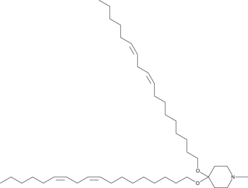STING
STING (Stimulator of Interferon Genes) is a transmembrane protein localized to the endoplasmic reticulum that undergoes a conformational change in response to direct binding of cyclic dinucleotides (CDNs), resulting in a downstream signaling cascade involving TBK1 activation, IRF-3 phosphorylation, and production of IFN-β and other cytokines.
STING is a pattern recognition receptor of cyclic dinucleotides as well as an innate immune adaptor protein that enables signaling from cytoplasmic receptors to the transcription factor interferon regulatory factor 3. Initiation of these pathways leads to the expression of type I interferons and proteins associated with antiviral and antitumor immunity. Small molecules capable of triggering STING-dependent cellular processes are effective at blocking virus replication, enhancing vaccine efficacy, and facilitating immune response to cancer cells.
Ziele für STING
Produkte für STING
- Bestell-Nr. Artikelname Informationen
-
GC49912
13C20,15N10-Cyclic di-GMP (sodium salt)
An internal standard for the quantification of cyclic di-GMP
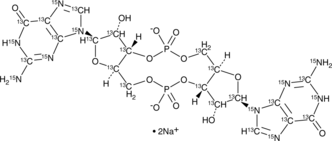
-
GC42080
2'2'-cGAMP (sodium salt)
2'2'-cGAMP is a synthetic dinucleotide (CDN) that contains non-canonical 2'5'-phosphodiester bonds.
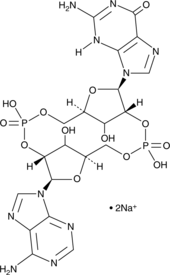
-
GC42090
2'3'-cGAMP (sodium salt)
2'3'-cGAMP is a second messenger produced from ATP and GTP by cGMP-AMP synthase (cGAS) in the cytoplasm of mammalian cells in response to the presence of DNA.

-
GC25014
3',3'-cGAMP
3',3'-cGAMP (3',3'-cyclic GMP-AMP, Cyclic GMP-AMP, cGAMP) activates the endoplasmic reticulum (ER)-resident receptor stimulator of interferon genes (STING), thereby inducing an antiviral state and the secretion of type I IFNs.
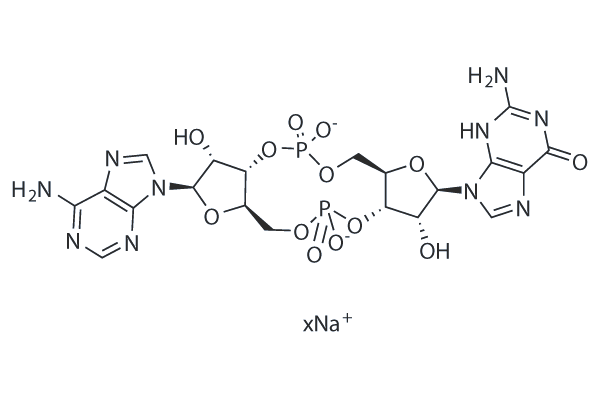
-
GC42245
3'3'-cGAMP (sodium salt)
3'3'-cGAMP is a second messenger produced in bacteria by specific dinucleotide cyclases.
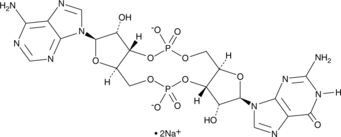
-
GC48381
5'-pApA (sodium salt)
A linearized form of cyclic di-AMP
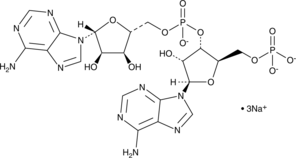
-
GC48375
5'-pGpG (sodium salt)
A linearized form of cyclic di-GMP
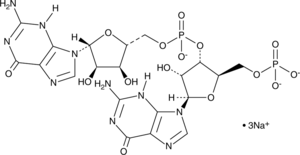
-
GC49238
93-O17S
A cationic lipidoid

-
GC31649
ADU-S100 (ML RR-S2 CDA)
ADU-S100 (ML RR-S2 CDA) (MIW815), ein Aktivator des Stimulators von Interferon-Genen (STING), fÜhrt zu einer potenten und systemischen Tumorregression und ImmunitÄt.
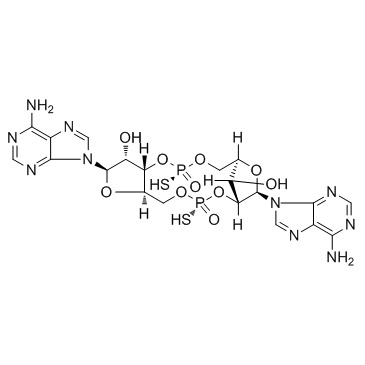
-
GC39161
ADU-S100 disodium salt
ADU-S100 Dinatriumsalz (MIW815 Dinatriumsalz) ist ein Aktivator des Stimulators von Interferon-Genen (STING).
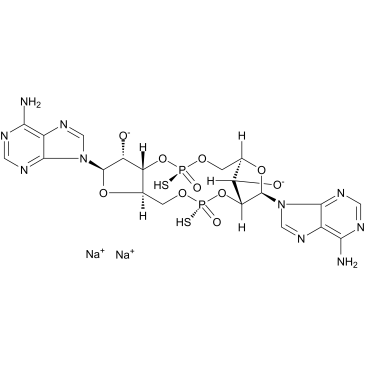
-
GC42880
Avenanthramide-C methyl ester
Avenanthramide-C methyl ester is an inhibitor of NF-κB activation that acts by blocking the phosphorylation of IKK and IκB (IC50 ~ 40 μM).
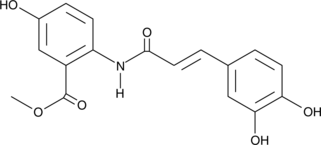
-
GC42953
BMS 345541 (trifluoroacetate salt)
BMS 345541 is a cell permeable inhibitor of the IκB kinases IKKα and IKKβ (IC50s = 4 and 0.3 μM).
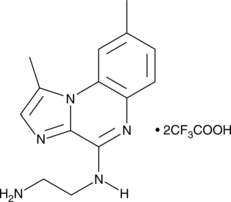
-
GC46983
C-170
C-170 (C-170) ist ein potenter und kovalenter STING-Inhibitor.

-
GC46984
C-171
C-171 ist ein Inhibitor des Stimulators von Interferon-Genen (STING).

-
GC33823
C-176 (STING inhibitor 1)
C-176 (STING-Inhibitor 1) ist ein starker und kovalenter Maus-STING-Inhibitor.
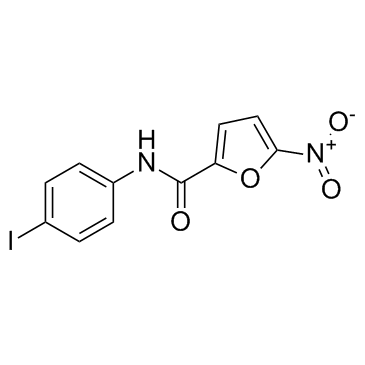
-
GC38494
C-178
C-178 ist ein potenter und selektiver kovalenter Inhibitor von STING.
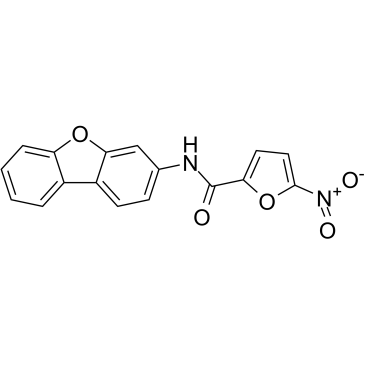
-
GC13643
c-di-AMP
c-di-AMP (cyclisches Diadenylat) ist ein STING-Agonist, der an das Transmembranprotein STING bindet und dadurch den TBK3-IRF3-Signalweg aktiviert, der anschließend die Produktion von Typ-I-IFN und TNF auslÖst.
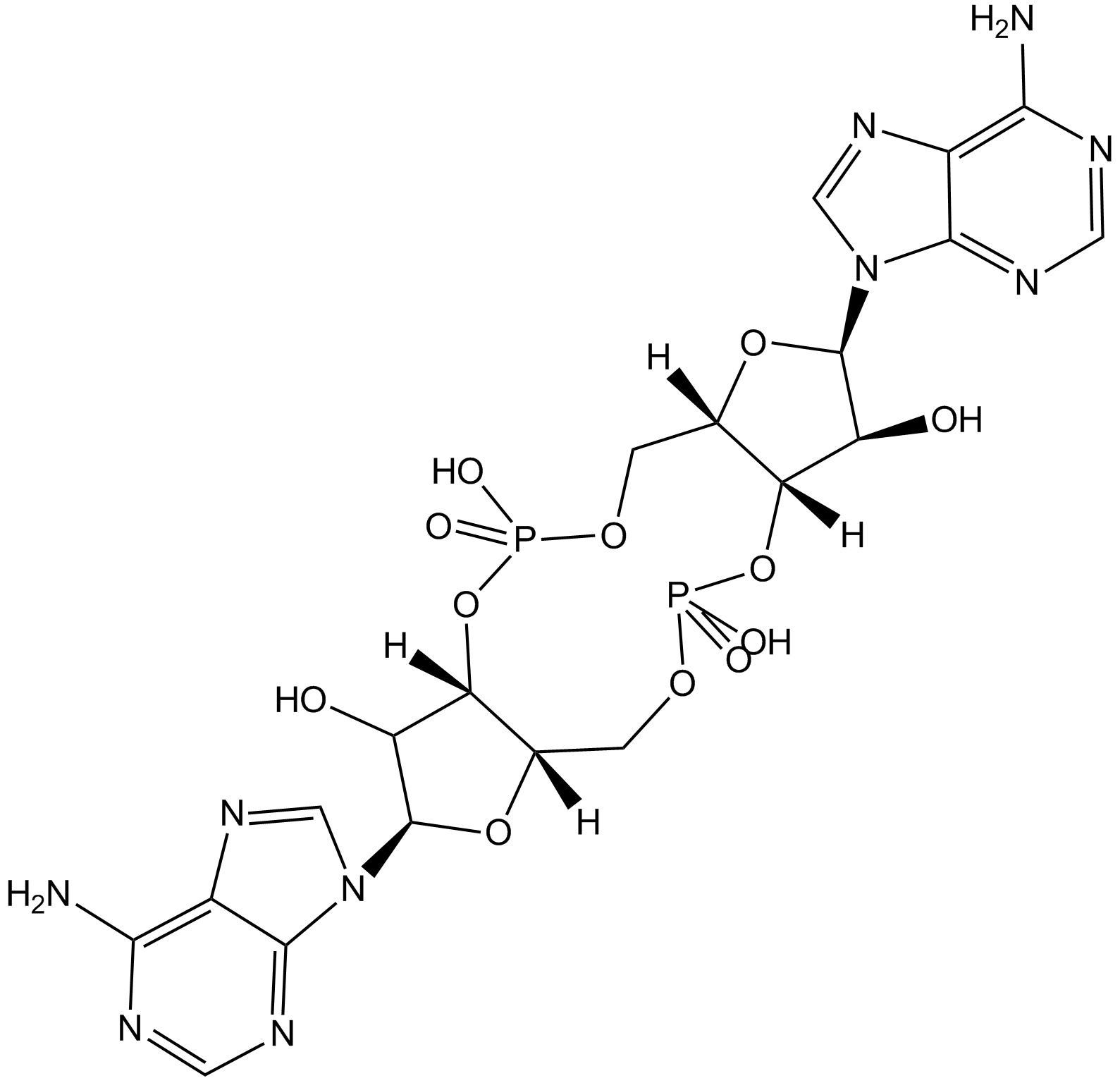
-
GC62893
c-di-AMP diammonium
c-di-AMP-Diammonium ist ein STING-Agonist, der an das Transmembranprotein STING bindet und dadurch den TBK3-IRF3-Signalweg aktiviert, der anschließend die Produktion von Typ-I-IFN und TNF auslÖst.
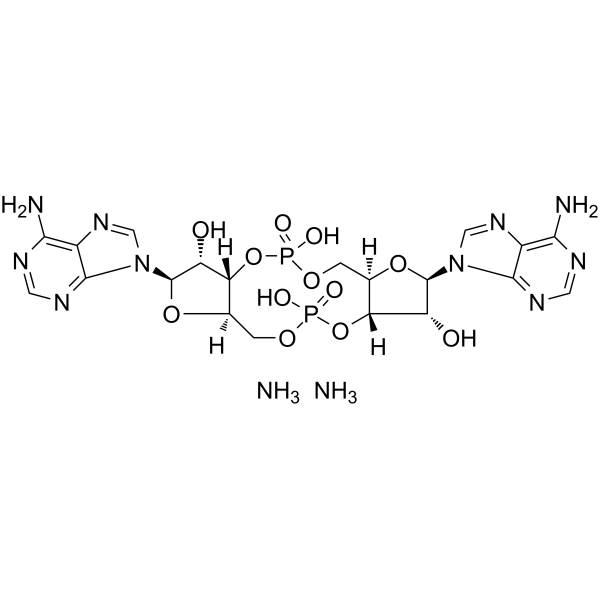
-
GC64445
c-di-AMP disodium
c-di-AMP (zyklisches Diadenylat)-Natrium ist ein STING-Agonist, der an das Transmembranprotein STING bindet und dadurch den TBK3-IRF3-Signalweg aktiviert, der anschließend die Produktion von Typ-I-IFN und TNF auslÖst.
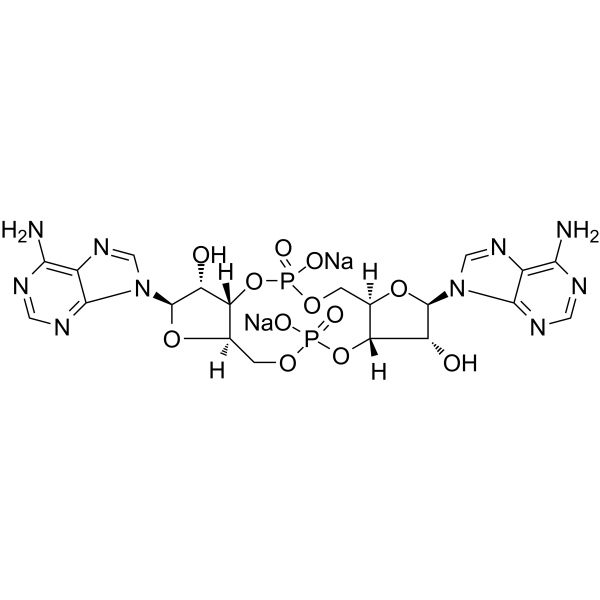
-
GC62198
c-di-AMP sodium
C-di-AMP is a STING agonist, which binds to the transmembrane protein STING, thereby activating the TBK3-IRF3 signaling pathway, subsequently triggering the production of type I IFN and TNF.
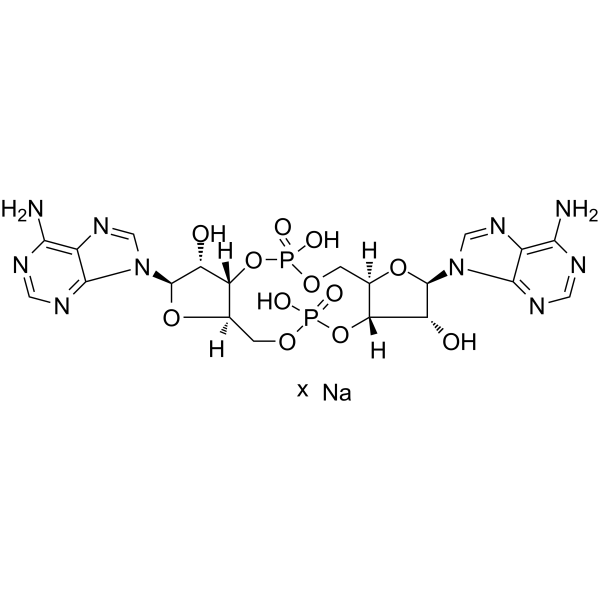
-
GC50687
c-Di-AMP sodium salt
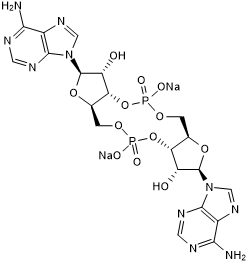
-
GC50292
c-Di-GMP sodium salt
Endogenous STING and DDX41 agonist; activates STING-dependent signaling
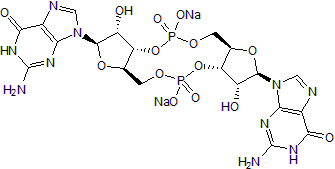
-
GC43176
CAY10575
CAY10575 (Verbindung 8) ist ein IKK2-Inhibitor mit einem IC50 von 0,075 μM.
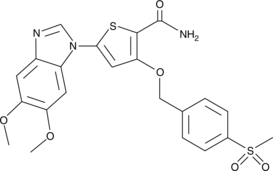
-
GC18782
CAY10657
The NF-κB/Rel family of transcription factors induce and coordinate the expression of pro-inflammatory genes including cytokines, chemokines, interferons, MHC proteins, growth factors, and cell adhesion molecules.
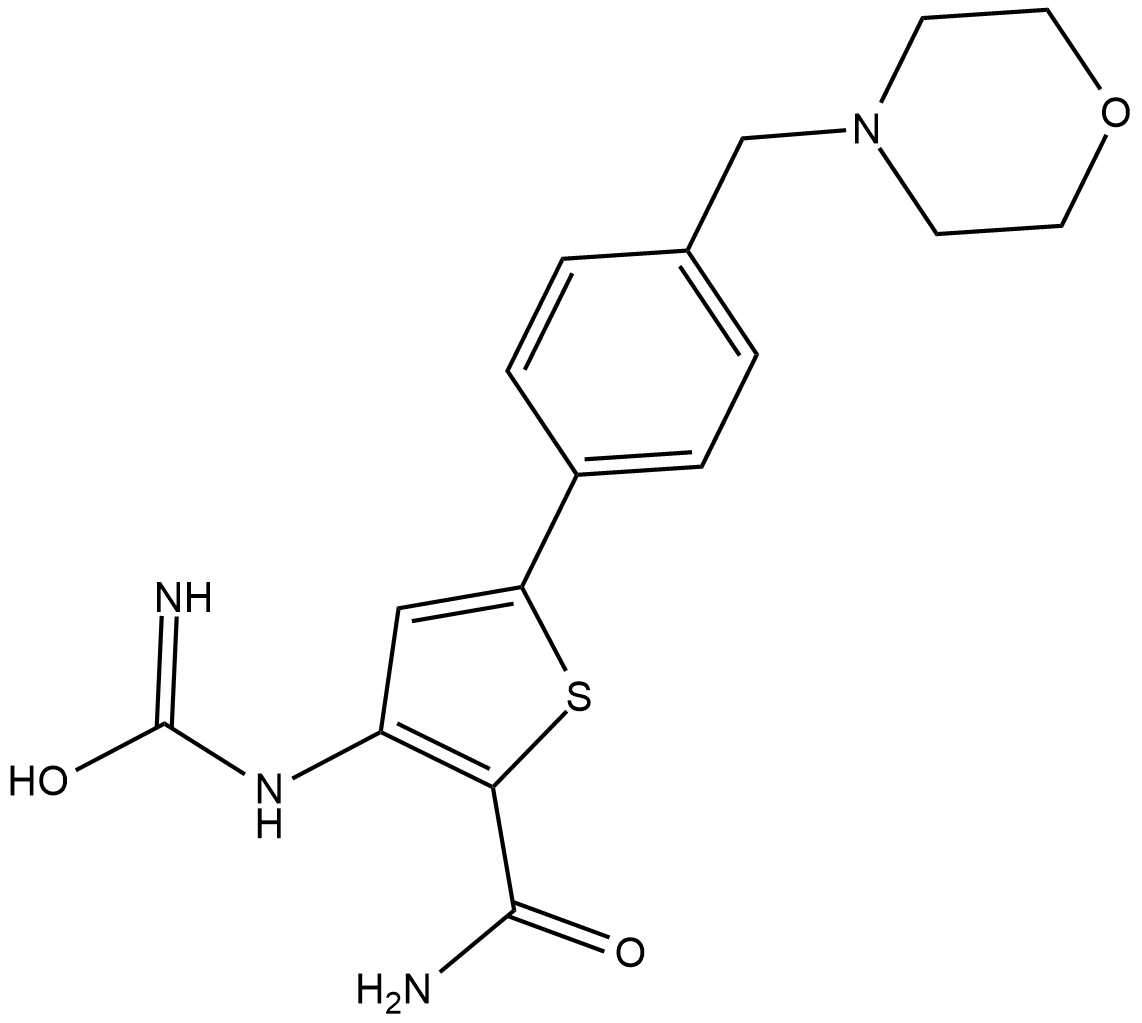
-
GC47054
CAY10748
A STING agonist
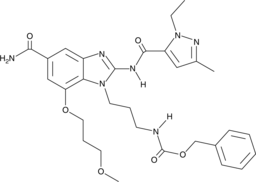
-
GC14727
CCCP
Carbonylcyanid-3-chlorphenylhydrazon (CCCP) ist ein Protonophor, das eine Entkopplung des Protonengradienten in der inneren Mitochondrienmembran verursacht und somit die Rate der ATP-Synthese hemmt.
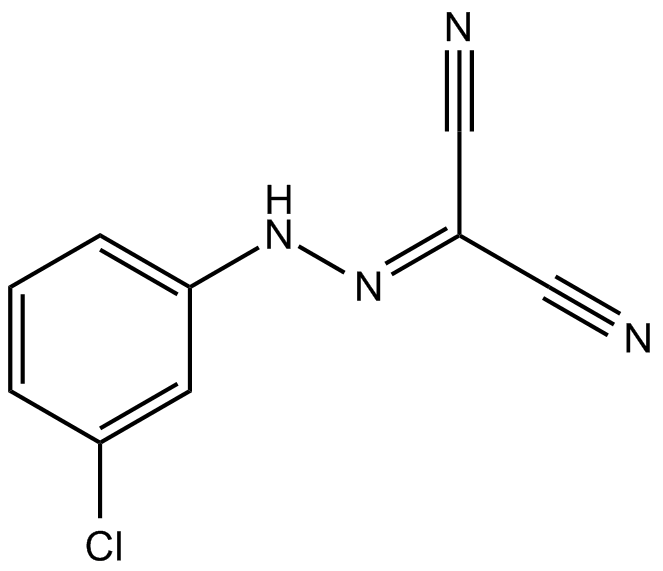
-
GC31696
cGAMP (Cyclic AMP-GMP)
cGAMP (Cyclic AMP-GMP) (Cyclic GMP-AMPP) fungiert als endogener Second Messenger in Metazoen und lÖst die Interferonproduktion als Reaktion auf zytosolische DNA aus.
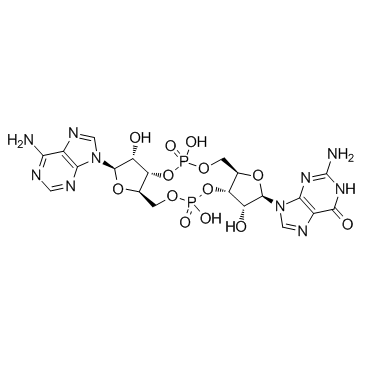
-
GC63758
cGAMP diammonium
cGAMP (Cyclic GMP-AMPP) Diammonium fungiert in Metazoen als endogener Second Messenger und lÖst die Interferonproduktion als Reaktion auf zytosolische DNA aus.
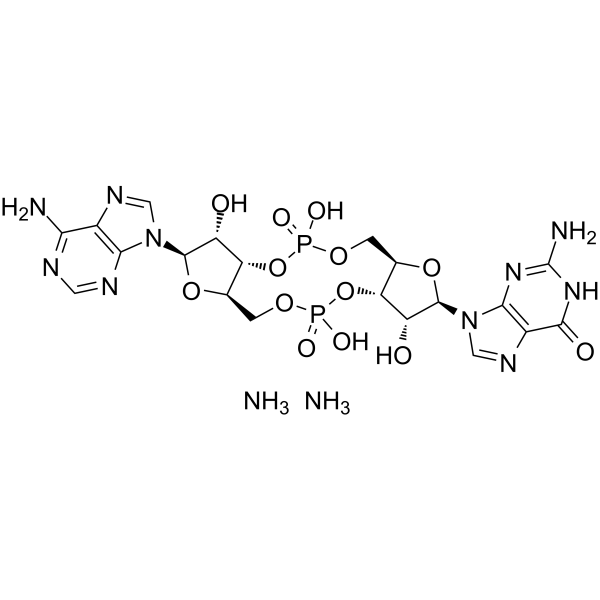
-
GC34329
ChX710
ChX710 kÖnnte die Typ-I-Interferon-Antwort auf zytosolische DNA auslÖsen, die die ISRE-Promotorsequenz, spezifische zellulÄre Interferon-stimulierte Gene (ISGs) und die Phosphorylierung von Interferon Regulatory Factor (IRF) 3 induziert.
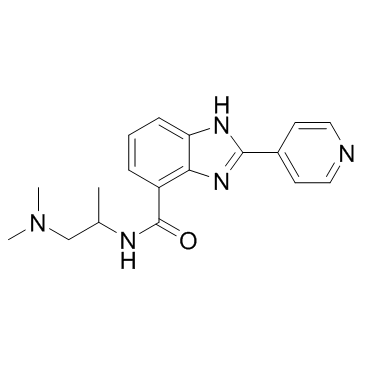
-
GC31875
CL656 (c-[2'FdAMP(S)-2'FdIMP(S)])
CL656 (c-[2'FdAMP(S)-2'FdIMP(S)]) ist ein Aktivator des Stimulators von Interferon-Genen (STING).
![CL656 (c-[2'FdAMP(S)-2'FdIMP(S)]) Chemical Structure CL656 (c-[2'FdAMP(S)-2'FdIMP(S)]) Chemical Structure](/media/struct/GC3/GC31875.png)
-
GC45413
Cridanimod (sodium salt)
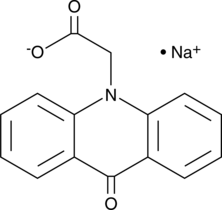
-
GC47128
CU-32
A cGAS inhibitor
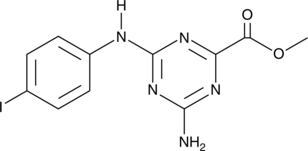
-
GC47129
CU-76
A cGAS inhibitor
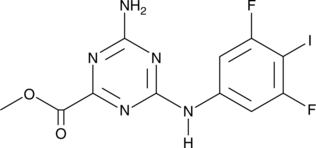
-
GC43339
Cyclic di-AMP (sodium salt)
Cyclic di-AMP (c-di-AMP) is a second messenger produced by bacteria but not by mammals.

-
GC15048
Cyclic di-GMP
Zyklisches di-GMP ist ein STING-Agonist und ein bakterieller Second Messenger, der verschiedene Aspekte des Bakterienwachstums und -verhaltens koordiniert, einschließlich Motilität, Virulenz, Biofilmbildung und Fortschreiten des Zellzyklus. Zyklisches di-GMP hat eine Anti-Krebszell-Proliferationsaktivität und induziert auch eine erhöhte CD4-Rezeptorexpression und einen Zellzyklusarrest. Zyklisches di-GMP kann in der Krebsforschung eingesetzt werden.
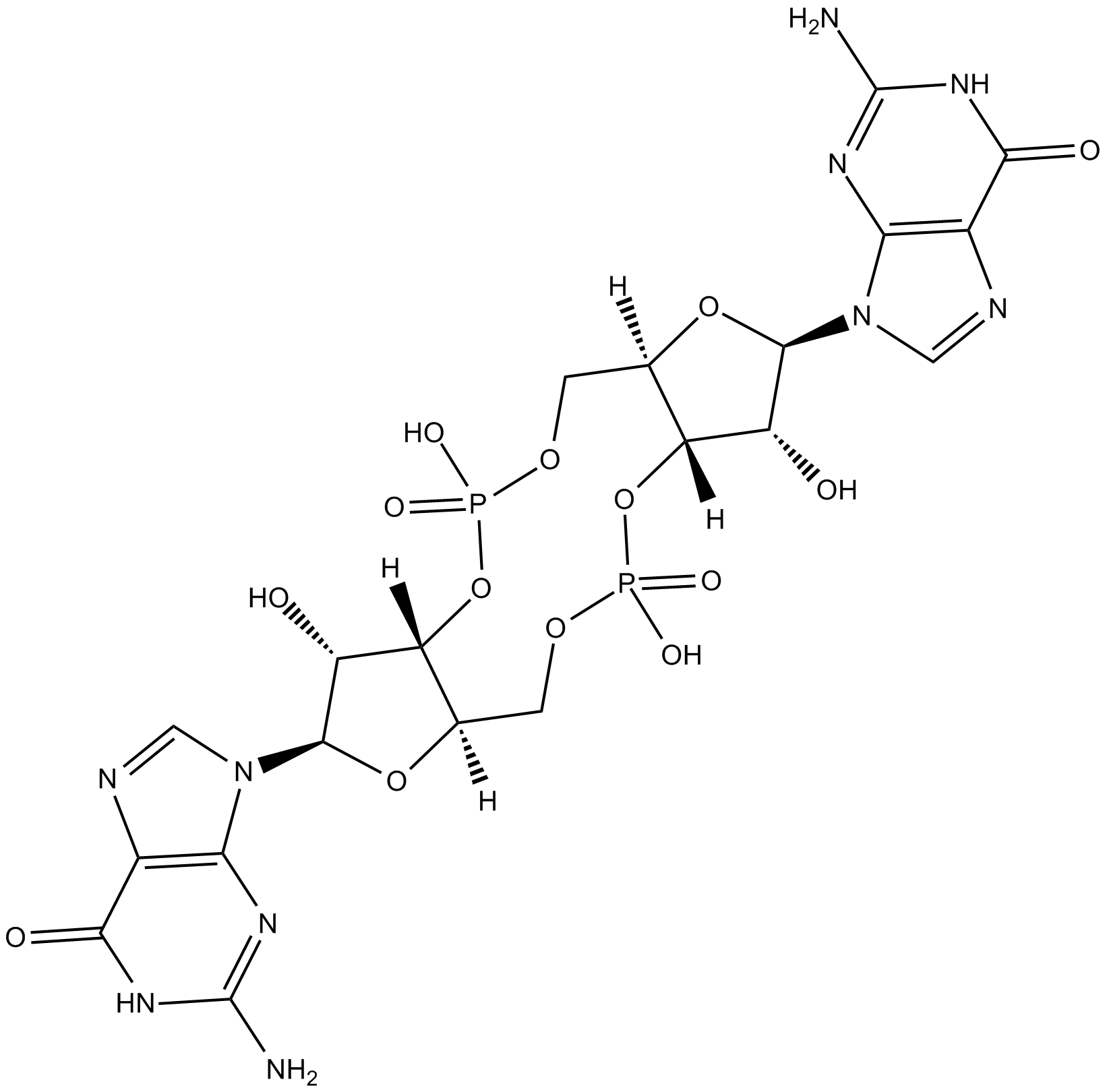
-
GC19526
Cyclic di-GMP (sodium salt)
Zyklisches di-GMP (Natriumsalz) ist ein STING-Agonist und ein bakterieller Second Messenger, der verschiedene Aspekte des Bakterienwachstums und -verhaltens koordiniert, einschließlich MotilitÄt, Virulenz, Biofilmbildung und Fortschreiten des Zellzyklus. Zyklisches di-GMP (Natriumsalz) hat eine Anti-KrebszellproliferationsaktivitÄt und induziert auch eine erhÖhte CD4-Rezeptorexpression und einen Zellzyklusarrest. Zyklisches di-GMP (Natriumsalz) kann in der Krebsforschung eingesetzt werden.
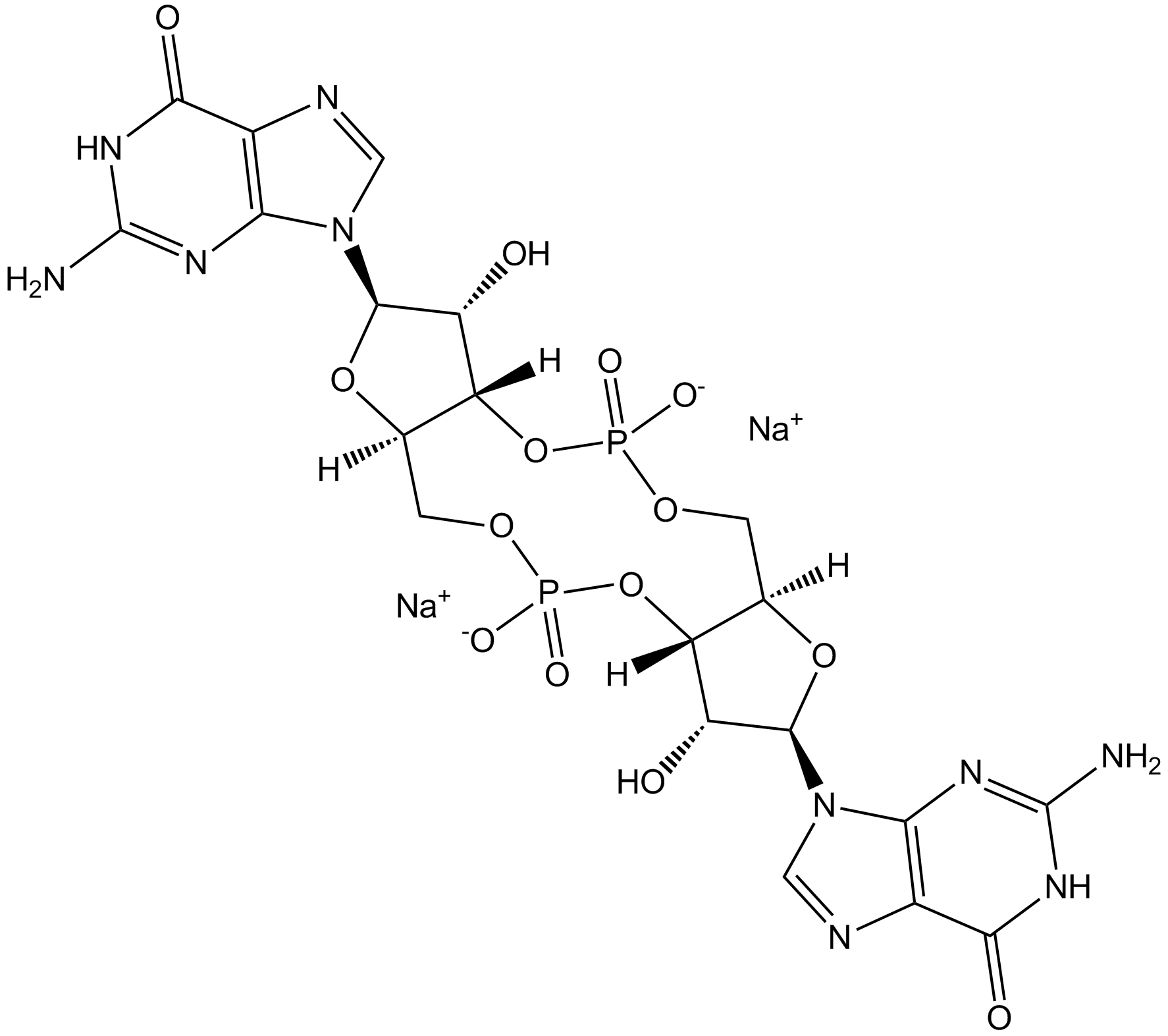
-
GC43340
Cyclic di-IMP (sodium salt)
Cyclic di-IMP (sodium salt) (c-di-IMP) is a synthetic second messenger structurally related to the bacterial second messengers cyclic di-GMP and cyclic di-AMP.
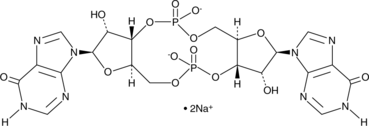
-
GC48397
Cyclic di-UMP (sodium salt)
A pyrimidine-containing CDN
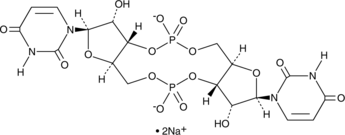
-
GC62917
Cyclic-di-GMP diammonium
Cyclic-di-GMP-Diammonium ist ein STING-Agonist und ein bakterieller Second Messenger, der verschiedene Aspekte des Bakterienwachstums und -verhaltens koordiniert, einschließlich MotilitÄt, Virulenz, Biofilmbildung und Fortschreiten des Zellzyklus. Cyclisches Di-GMP-Diammonium hat eine Anti-KrebszellproliferationsaktivitÄt und induziert auch eine erhÖhte CD4-Rezeptorexpression und einen Zellzyklusarrest. Cyclic-di-GMP-Diammonium kann in der Krebsforschung eingesetzt werden.
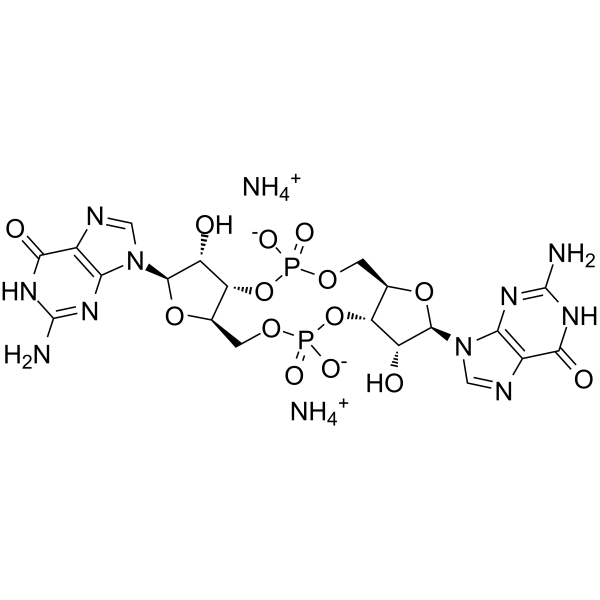
-
GC62372
Cyclic-di-GMP sodium
Cyclic-di-GMP-Natrium ist ein STING-Agonist und ein bakterieller Second Messenger, der verschiedene Aspekte des Bakterienwachstums und -verhaltens koordiniert, einschließlich MotilitÄt, Virulenz, Biofilmbildung und Fortschreiten des Zellzyklus. Cyclisches Di-GMP-Natrium hat eine Anti-KrebszellproliferationsaktivitÄt und induziert auch eine erhÖhte CD4-Rezeptorexpression und einen Zellzyklusarrest. Cyclic-di-GMP-Natrium kann in der Krebsforschung eingesetzt werden.
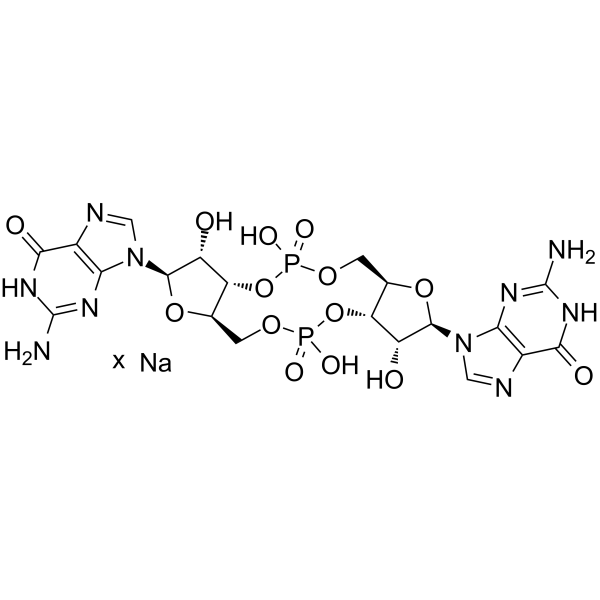
-
GC35853
diABZI STING agonist-1
diABZI STING Agonist-1 ist ein selektiver Stimulator des Interferongene (STING)-Rezeptoragonisten mit EC50-Werten von 130 bzw. 186 nM fÜr Mensch und Maus.
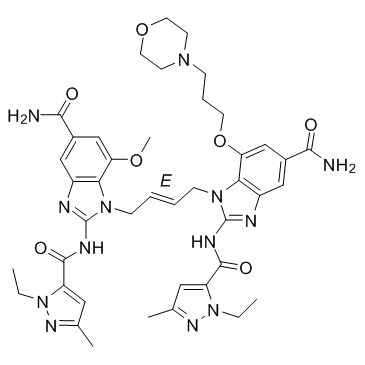
-
GC35854
diABZI STING agonist-1 Tautomerism
diABZI STING Agonist-1 Tautomerism (Verbindung 3) ist ein selektiver Stimulator des Interferon-Gen-(STING)-Rezeptoragonisten mit EC50-Werten von 130 bzw. 186 nM für Mensch und Maus.
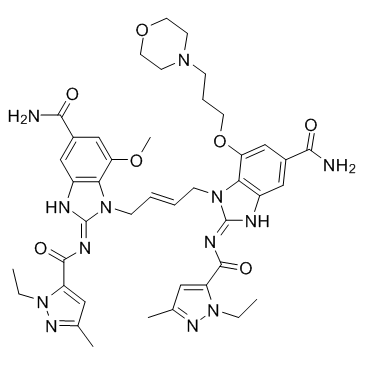
-
GC35855
diABZI STING agonist-1 trihydrochloride
diABZI STING Agonist-1 Trihydrochlorid, als STING-Agonist, wird durch einen unbekannten Rezeptor in den Cytoplasma aufgenommen und führt zur Aktivierung und Dimerisierung von STING gefolgt von TBK1/IRF3 Phosphorylierung, was zu einer Typ-I-IFN-Reaktion führt.
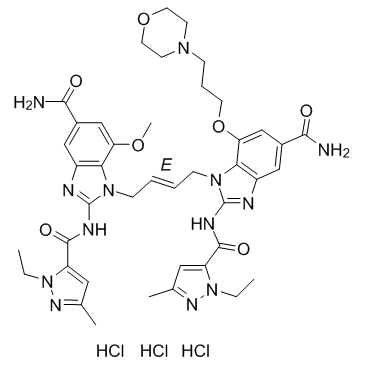
-
GC63473
diABZI-C2-NH2
diABZI-C2-NH2, ein aktives Analogon mit einer primÄren AminfunktionalitÄt, ist ein STING-Agonist.
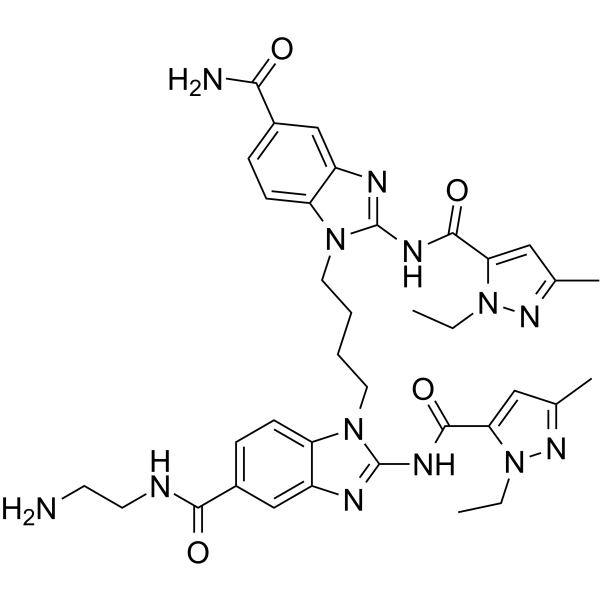
-
GC16280
DMXAA (Vadimezan)
Ein STING-Aktivator und Tumor-vaskulärer Unterbrecher.
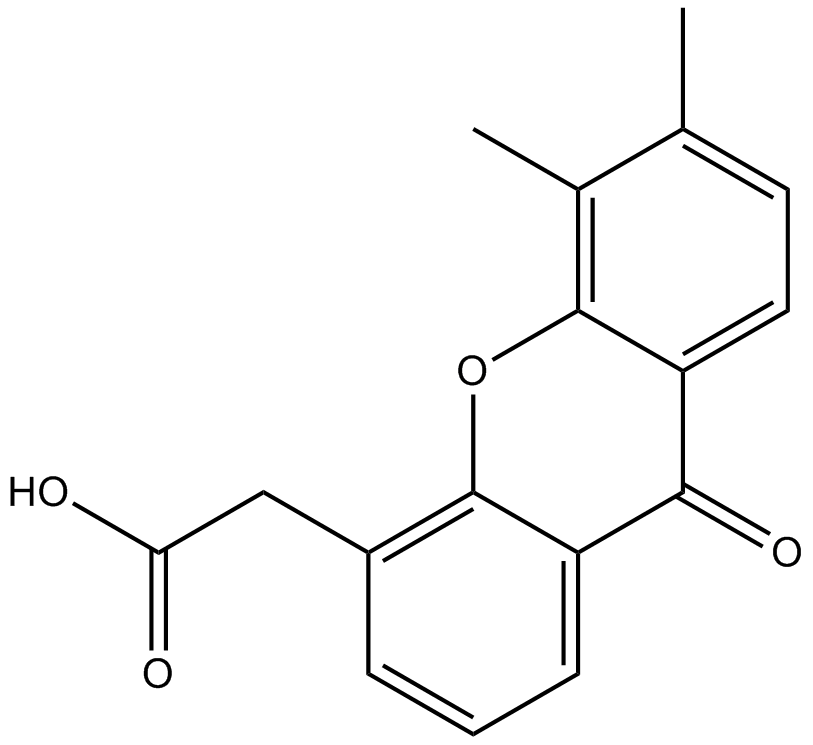
-
GC62608
E7766 diammonium salt
E7766 Diammoniumsalz ist ein Makrocyclus-verbrÜckter STING-Agonist mit einem Kd von 40 nM. E7766 Diammoniumsalz zeigt starke pangenotypische und AntitumoraktivitÄten.
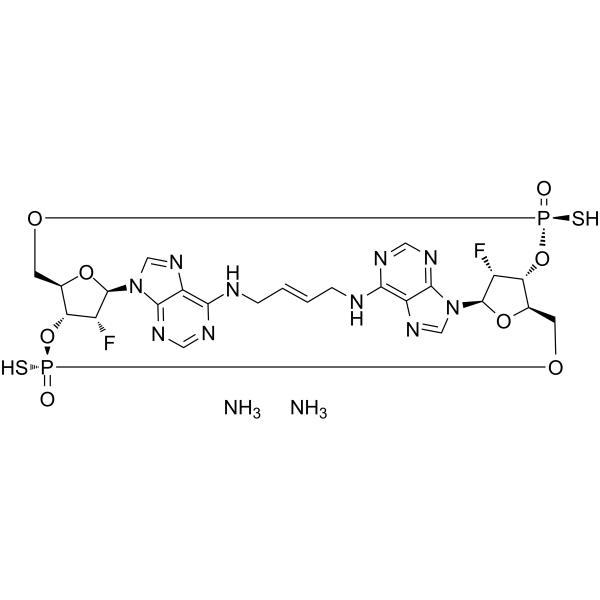
-
GC62609
E7766 disodium
E7766 Dinatrium ist ein Makrocyclus-verbrÜckter STING-Agonist mit einem Kd von 40 nM. E7766 Dinatrium zeigt starke pangenotypische und AntitumoraktivitÄten.
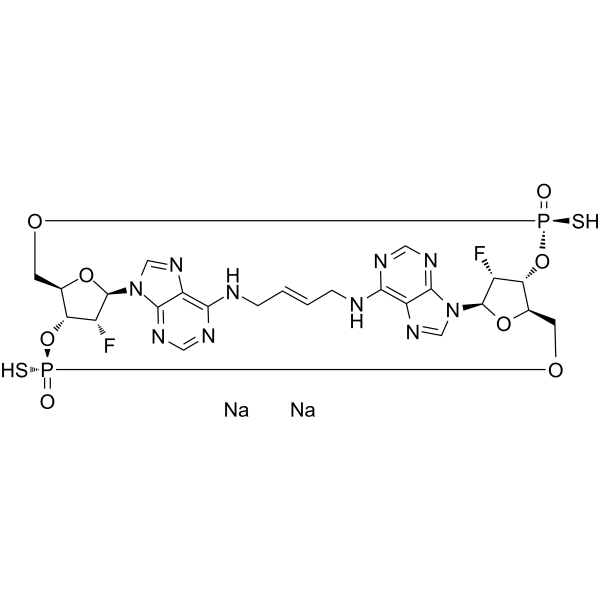
-
GC52334
ENPP1 Inhibitor 4e
An ENPP1 inhibitor
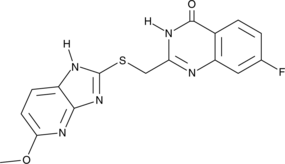
-
GC34610
H-151
H-151 ist ein potenter, selektiver und kovalenter Antagonist von STING, der sowohl in Zellen als auch in vivo eine bemerkenswerte inhibitorische AktivitÄt aufweist.
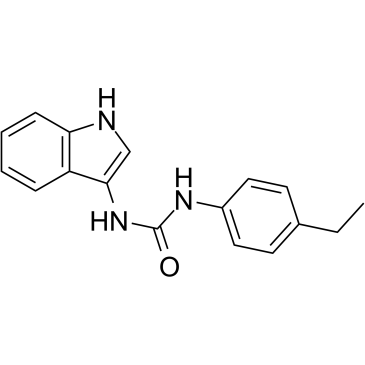
-
GC63012
IACS-8803 diammonium
IACS-8803 Diammonium ist ein hochpotenter zyklischer Dinukleotid-STING-Agonist. IACS-8803-Diammonium hat eine robuste systemische Antitumorwirksamkeit.
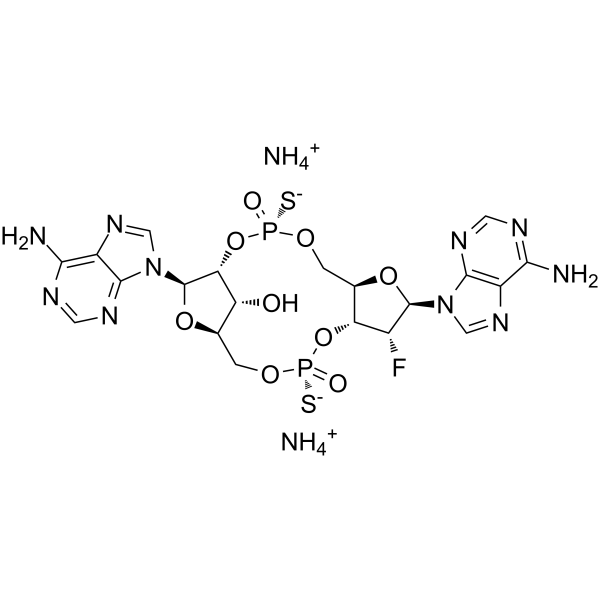
-
GC62586
IACS-8803 disodium
IACS-8803 Dinatrium ist ein hochpotenter zyklischer Dinukleotid-STING-Agonist. IACS-8803 Dinatrium hat eine robuste systemische Antitumorwirksamkeit.
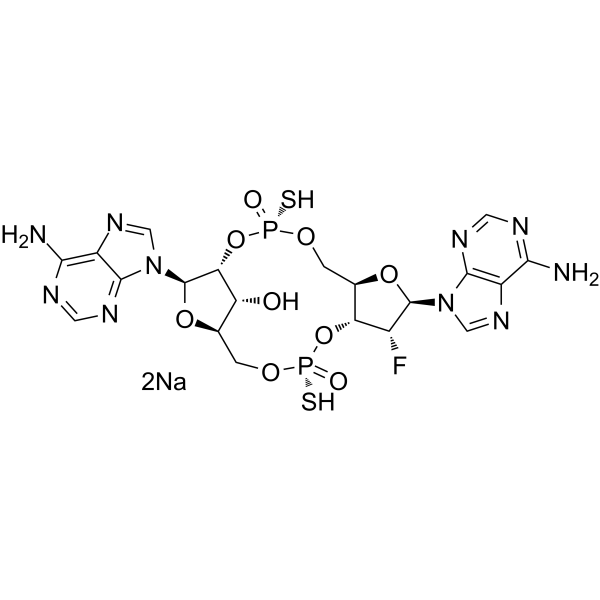
-
GC43894
IKK2 Inhibitor VI
Inhibitor of NF-κB kinase 2 (IKK2, also known as IKKβ) acts as part of an IKK complex in the canonical NF-κB pathway, phosphorylating inhibitors of NF-κB (IκBs) to initiate signaling.
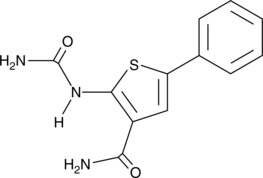
-
GC52291
KAS 08
A STING activator
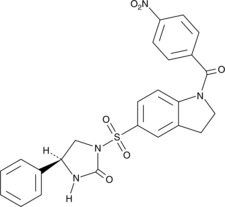
-
GC49673
M04
A STING agonist
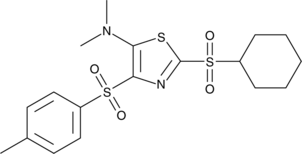
-
GC18988
ML RR-S2 CDA (ammonium salt)
ML RR-S2 CDA (Ammoniumsalz) (MIW815 Ammoniumsalz), ein Aktivator des Stimulators von Interferon-Genen (STING), fÜhrt zu einer potenten und systemischen Tumorregression und ImmunitÄt.
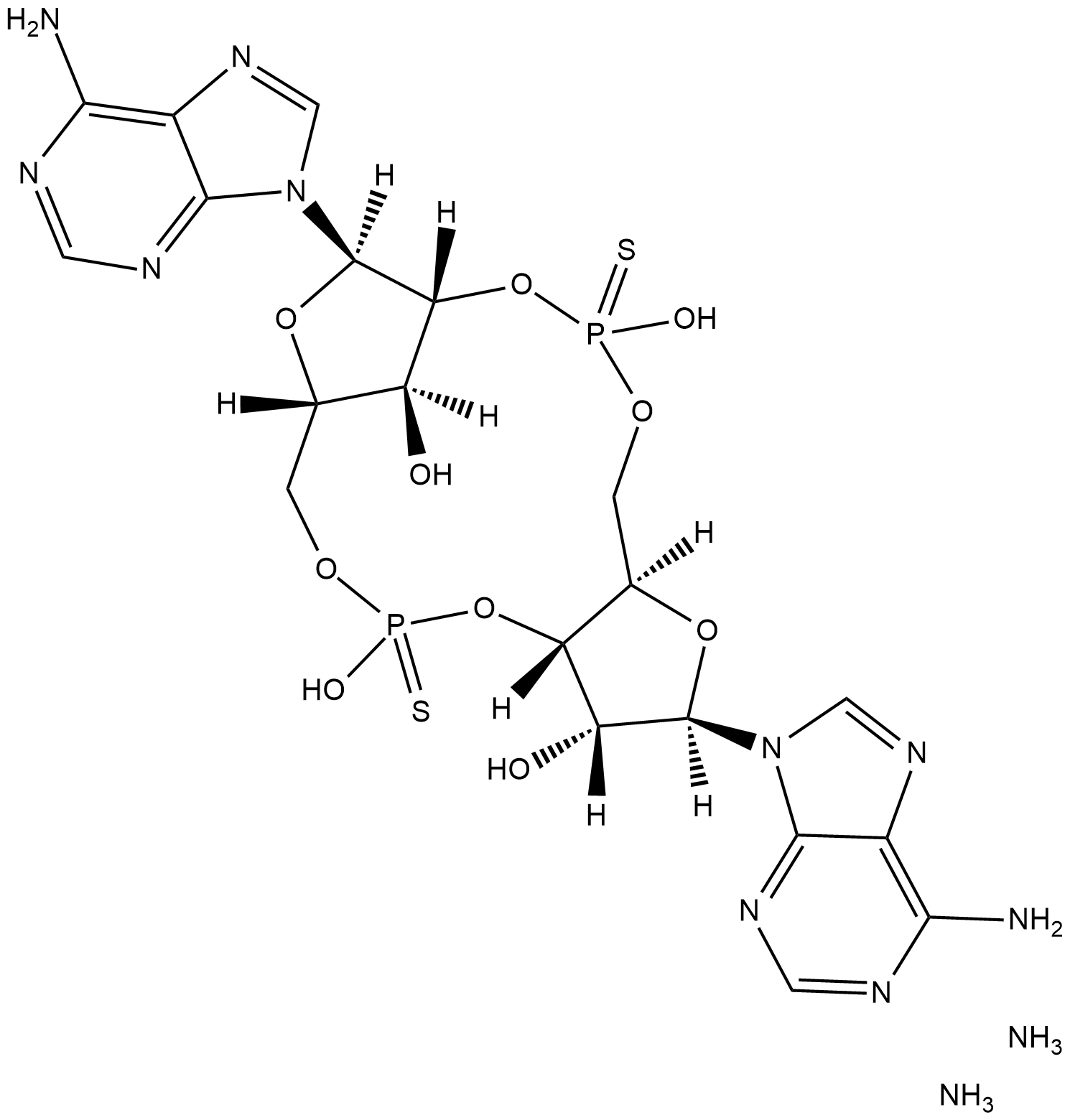
-
GC61092
MSA-2
MSA-2, ein potenter und oral verfÜgbarer Nicht-Nukleotid-STING-Agonist, wird als nicht-kovalentes Dimer mit nanomolarer AffinitÄt an STING gebunden.
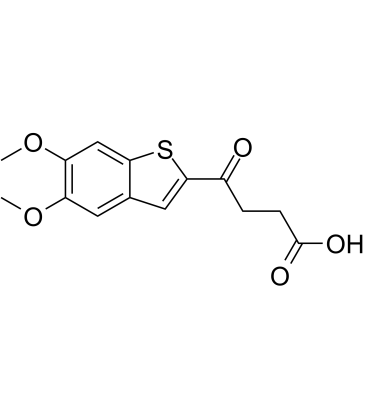
-
GC63082
MSA-2 dimer
MSA-2-Dimer ist ein selektiver, oral aktiver Nicht-Nukleotid-STING-Agonist (Kd = 145 μM) mit langfristiger Antitumor- und immunogener AktivitÄt.
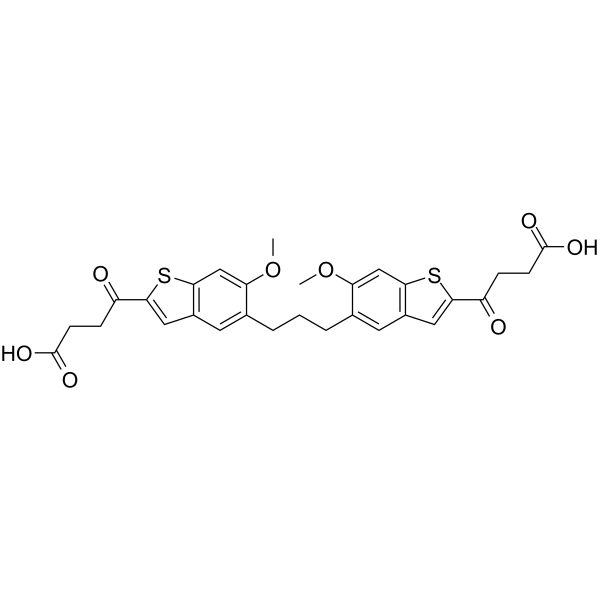
-
GC44388
NF-κB Control
NF-κB inhibitor is a synthetic peptide corresponding to the nuclear localization sequence (NLS) of NF-κB p105 subunit (also known as p50) appended to a hydrophobic sequence to facilitate import into living cells.

-
GC48985
NF-κB Inhibitor (trifluoroacetate salt)
A cell-permeable peptide that blocks nuclear import of NF-κB

-
GC13693
Omaveloxolone (RTA-408)
Omaveloxolon (RTA-408) (RTA 408) ist ein antioxidativer EntzÜndungsmodulator (AIM), der Nrf2 aktiviert und Stickstoffmonoxid (NO) unterdrÜckt.
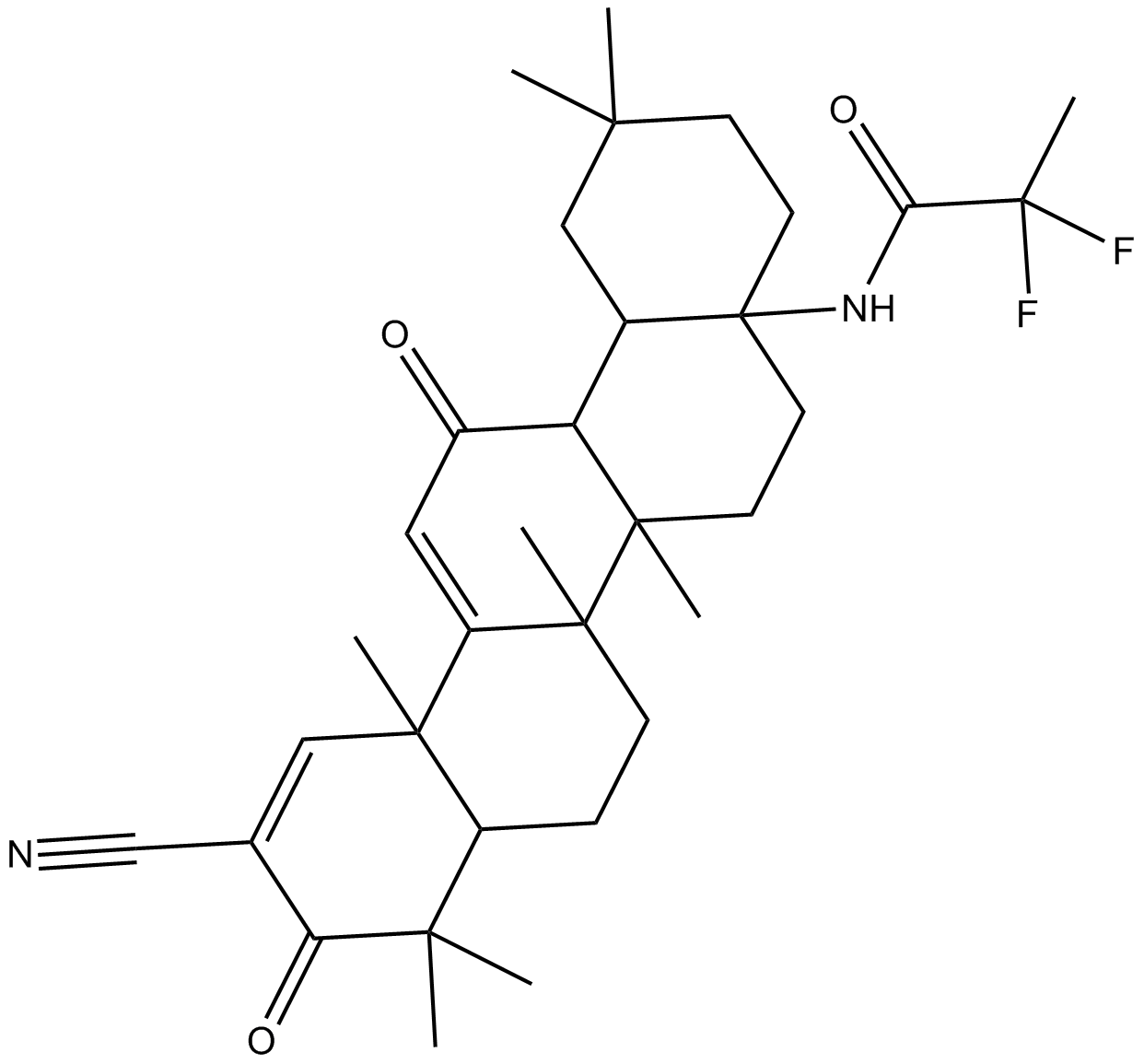
-
GC66392
PROTAC STING Degrader-1
PROTAC STING Degrader-1 (Verbindung SP23) ist ein STING PROTAC-Degradierer mit einer DC50 von 3,2 μM. PROTAC STING Degrader-1 zeigt eine entzündungshemmende Aktivität.
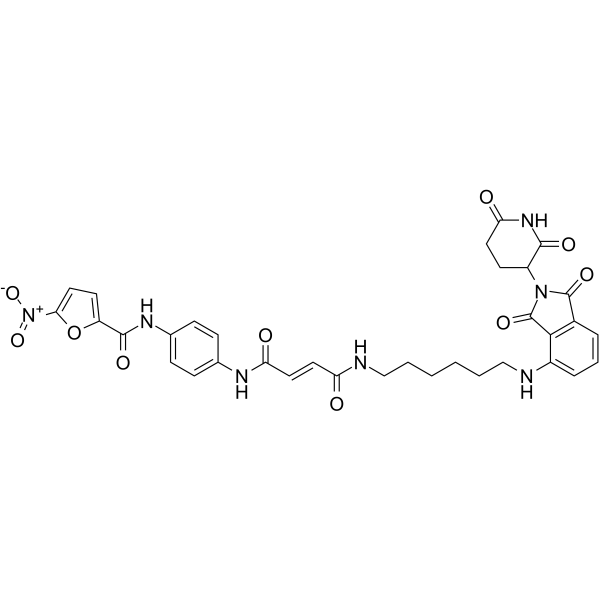
-
GC67719
SN-001

-
GC63905
SN-008
SN-008, ein weniger aktives SN-011-Analogon, kann als Negativkontrolle verwendet werden.
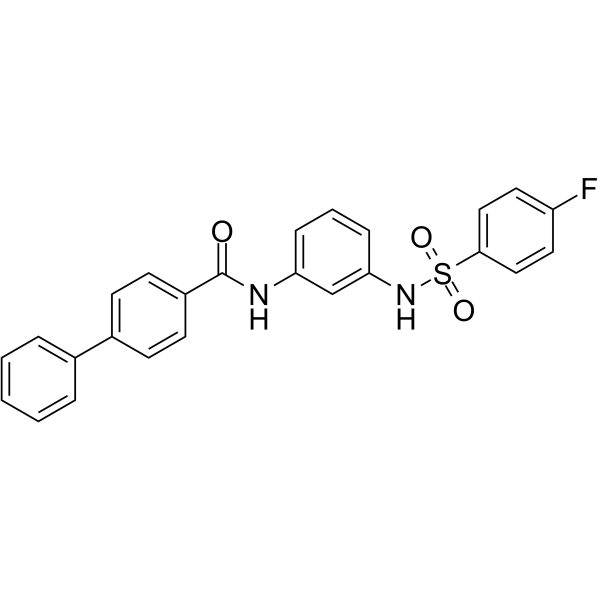
-
GC49400
SN-011
SN-011 ist ein potenter und selektiver Maus- und Human-STING-Inhibitor mit einem IC50-Wert von 76 nM fÜr die STING-Signalgebung.
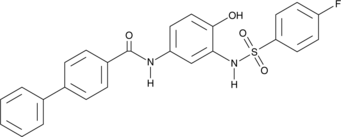
-
GC61293
SR-717
SR-717 ist ein Nicht-Nukleotid-STING-Agonist mit EC50-Werten von 2,1 μM und 2,2 μM in ISG-THP1 (WT)- bzw. ISG-THP1 cGAS KO (cGAS KO)-Zelllinien.
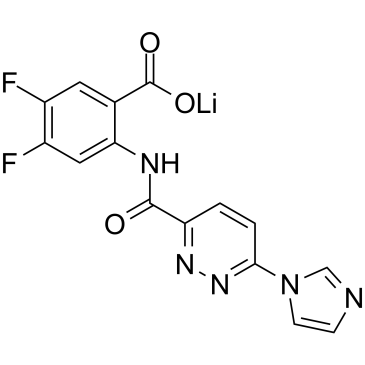
-
GC44948
StA-IFN-1
StA-IFN-1 is an inhibitor of the interferon (IFN) induction pathway with an IC50 value of 4.1 μM in a GFP reporter assay for IFN induction similar to TPCA-1, which specifically inhibits the IKKβ component of the IFN induction pathway.
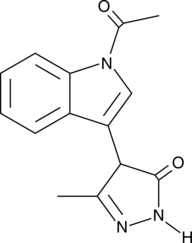
-
GC48109
STING Agonist 12b
A STING agonist
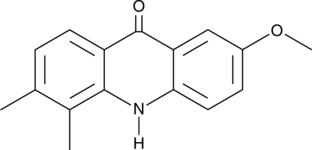
-
GC48110
STING Agonist 1a
STING-Agonist 1a (1a) ist ein spezifischer Stimulator von Interferon-Genen (STING)-Agonist.
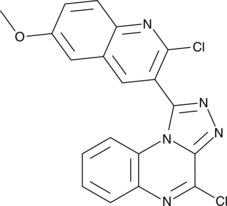
-
GC45570
STING Agonist C11
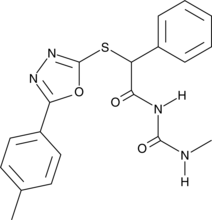
-
GC12943
STING agonist-1
STING-Agonist-1 (G10) ist ein humanspezifischer STING-Agonist, der eine antivirale AktivitÄt gegen neu auftretende Alphaviren hervorruft.
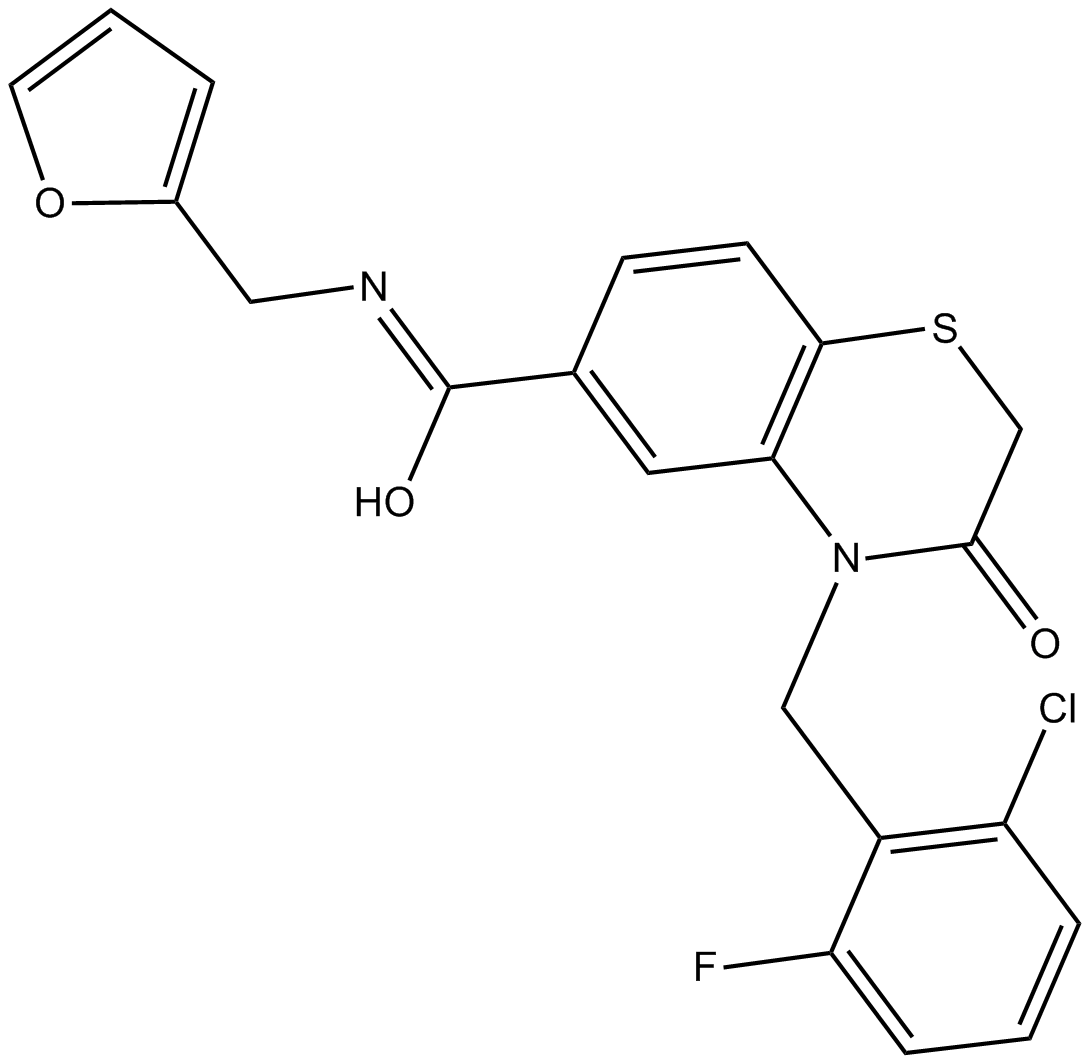
-
GC65282
STING agonist-12
STING-Agonist-12 (Verbindung 53) ist ein potenter, oral aktiver humaner STING-Aktivator mit einem EC50 von 185 nM.
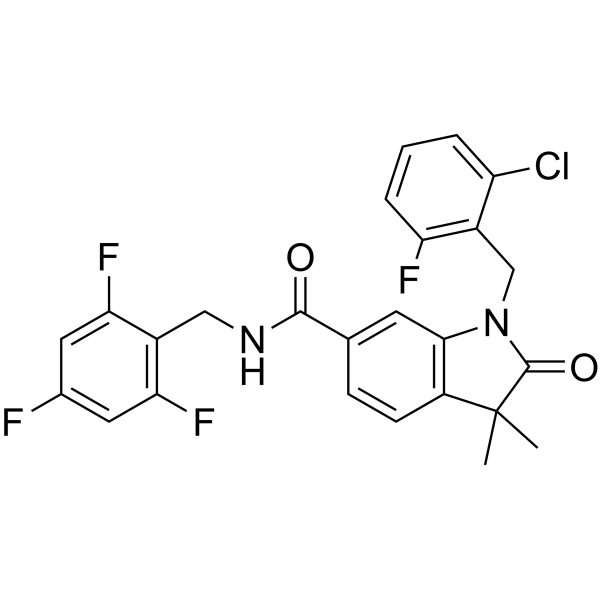
-
GC69959
STING agonist-20
STING-Agonist-20 (Verbindung 95) is an effective STING agonist used in the synthesis of XMT-2056. STING-Agonist-20 can be used as a vaccine adjuvant for cancer and other inflammatory and immunological diseases research.
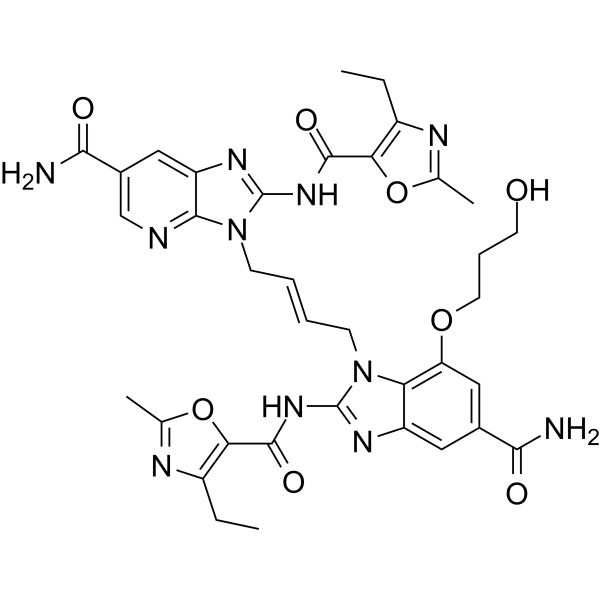
-
GC69961
STING agonist-22
STING-Agonist-22 (CF501) is an effective non-nucleotide STING agonist. STING-Agonist-22 is an adjuvant that induces type I interferon (IFN-I) response and pro-inflammatory cytokine production by activating STING. STING-Agonist-22 can be used as an adjuvant to enhance the efficacy, breadth, and durability of immune protection generated by a protein vaccine. It can also be used in research on SARS-CoV-2 variants and sarbecovirus diseases.
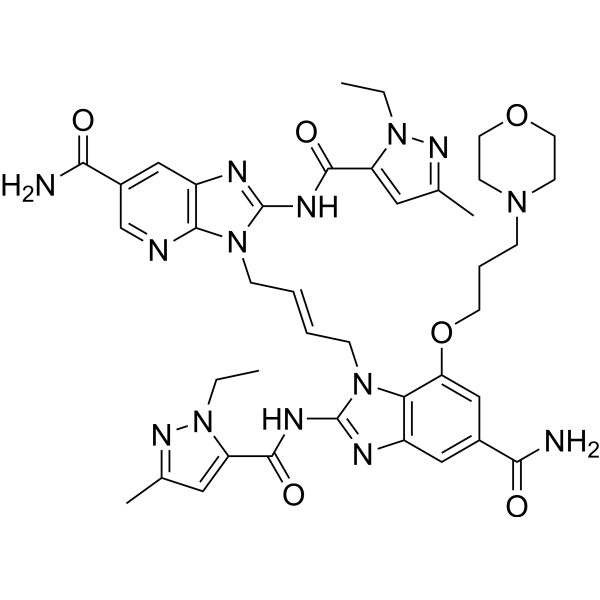
-
GC37692
STING agonist-3
STING-Agonist-3, extrahiert aus dem Patent WO2017175147A1 (Beispiel 10), ist ein selektiver und nicht-Nukleotid-STING-Agonist aus kleinen MolekÜlen mit einem pEC50 und pIC50 von 7,5 bzw. 9,5. Der STING-Agonist-3 hat eine dauerhafte Antitumorwirkung und ein enormes Potenzial zur Verbesserung der Krebsbehandlung.
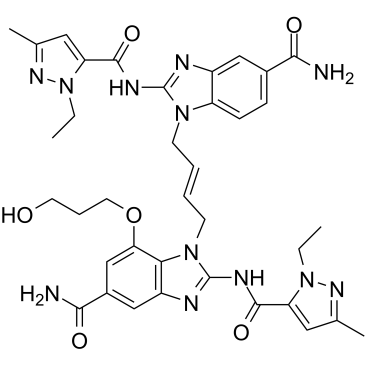
-
GC69962
STING agonist-3 trihydrochloride
STING-Agonist-3 Trihydrochlorid stammt aus dem Patent WO2017175147A1 (Beispiel 10) und ist ein selektiver und nicht-nukleotidischer kleiner Molekül-STING-Agonist mit einem pEC50 von 7,5 und einem pIC50 von 9,5. STING-Agonist-3 Trihydrochlorid hat eine langanhaltende antitumorale Wirkung und besitzt ein enormes Potenzial zur Verbesserung der Krebsforschung.
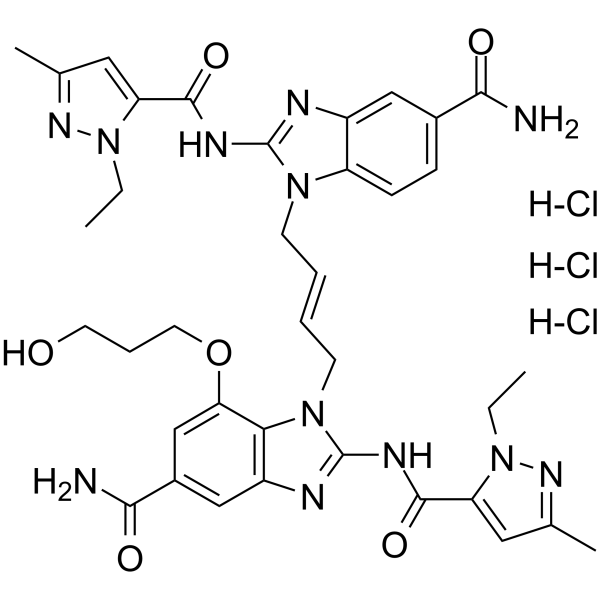
-
GC37693
STING agonist-4
STING-Agonist-4 ist ein Stimulator des Interferon-Gen-(STING)-Rezeptoragonisten mit einer scheinbaren Hemmkonstante (IC50) von 20 nM. STING-Agonist-4 ist eine auf zwei Symmetrien verwandte Amidobenzimidazol (ABZI)-basierte Verbindung, um verbundene ABZIs (diABZIs) mit verstÄrkter Bindung an STING und Zellfunktion zu erzeugen.
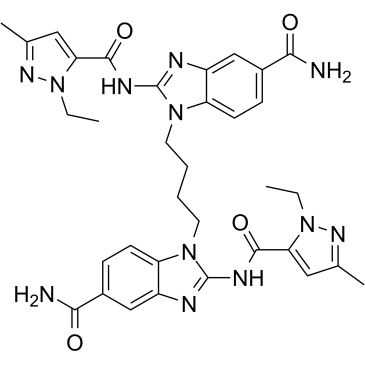
-
GC66008
STING agonist-7
STING-Agonist-7 ist ein Nicht-Nukleotid-STING-Agonist. STING-Agonist-7 bindet selektiv an Maus-STING, aber nicht an humanes STING. STING-Agonist-7 dringt schlecht in die Zellmembran ein.
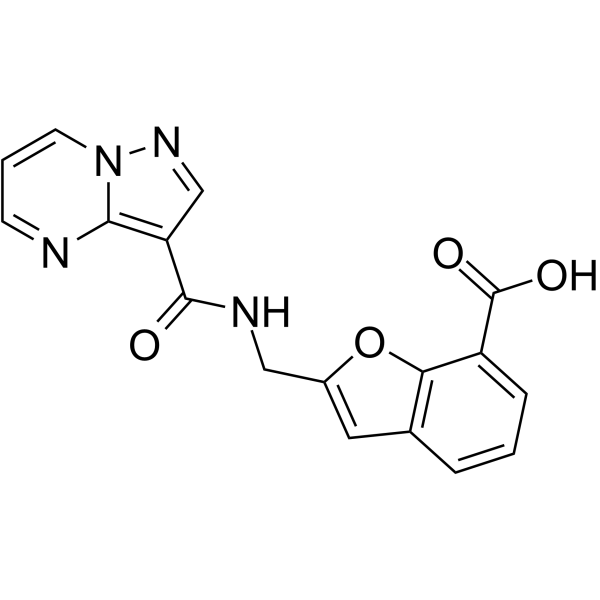
-
GC69963
STING agonist-8 dihydrochloride
STING-Agonist-8-Dihydrochlorid (5-AB) ist ein wirksamer STING-Agonist mit einer EC50 von 27 nM in THP1-Dual KI-hSTING-R232-Zellen.
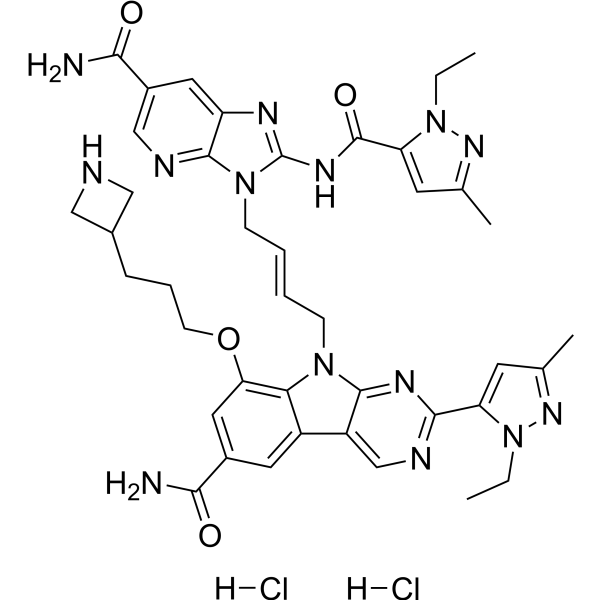
-
GC34322
STING ligand-1
STING-Ligand-1 ist ein fÜhrender STING-Ligand mit einem IC50 von 68 nM fÜr HAQ STING.
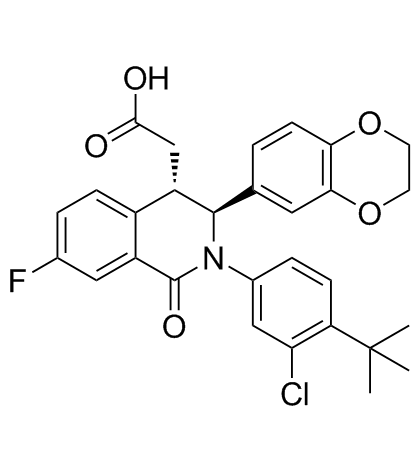
-
GC46227
STING18
A competitive STING ligand
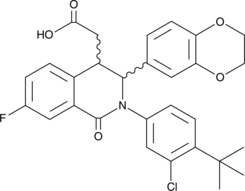
-
GC52084
YSK05
YSK05 ist ein pH-empfindliches kationisches Lipid. YSK05 verbessert den intrazellulÄren Transport nicht-viraler Vektoren. YSK05-MEND zeigt eine signifikant gute Gene-Silencing-AktivitÄt und hÄmolytische AktivitÄt. YSK05 Überwindet die UnterdrÜckung des endosomalen Entkommens durch PEGylierung. YSK05 verbessert effektiv die siRNA-Abgabe sowohl in vitro als auch in vivo.
